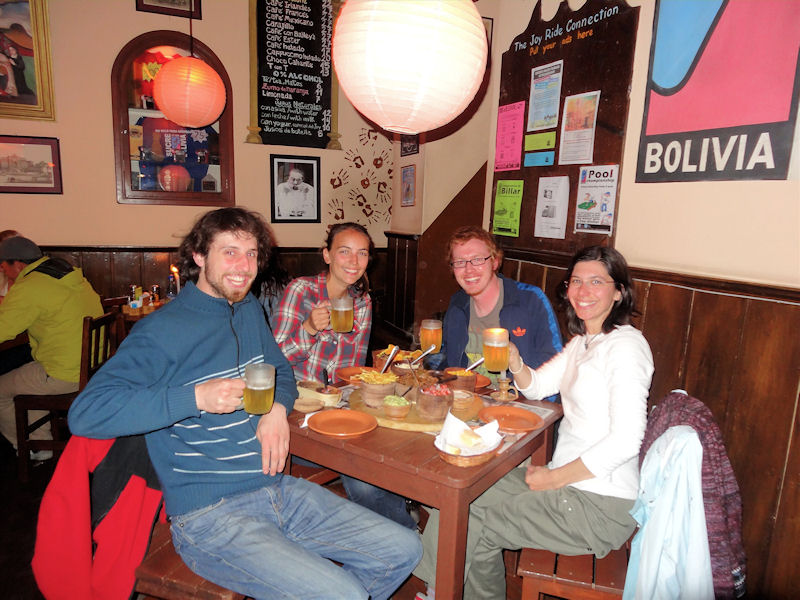O fficially – that is, according to the constitution – Sucre is still the capital of Bolivia, but the de facto legislative and executive centre is La Paz and has been so for more than 100 years. Architecturally, the city is a marvel thanks to its role as the home of the conservative and wealthy, a badge it still wears.
Our little Uyuni group was whittling away as members went their own way and, as we had arrived by taxi on that chilly night in Potosí, so we arrived again by private taxi to Sucre, only this time it was a sunny and mild afternoon. Oh it was all just so adventurous! The adventure began when trying to find a hostel. We poked our western noses into a variety of dingy accommodation offerings, each competing with each other for the rank of ‘worst hostel on trip’. You see the problem is that Sucre is very touristic making travel guides like Lonely Planet useless as a reference for accommodation because that’s what everyone else is also using. One hour later, disconsolately, we settled for a more expensive option. Happily, I chose the room with the broken TV for which I was offered a discount. No skin off my nose because who watches TV in a hostel? That’s like watching a nature doco in a national park.
Of the plethora of options which Sucre offers tourists in the form of outdoor activities, I partook in nothing. But there is one aspect of the South American way of life which I noticed most strongly in Sucre. That of socialising and congregating in squares and streets, the latter being a more Bolivian and Peruvian custom. On mild sunny afternoons, such as predominate in Sucre’s dry sunny climate, people, both old and young; amass in the squares to partake of each others company. Young children sit near the fountain in the sun, old men sit on benches in the shade, and youths stand gossiping in small groups, often sporting juvenile haircuts and/or cell phones blaring a distinct Latino pop. But they’re there, enjoying their public spaces to a degree Australian councils only dream of. This isn’t Facebook, this is Faceworld, and it’s still corporeal.
Moving away from the square towards the central markets, the streets remained full of people and not just those in transit, but also street venders and a kind of ‘window shopping’ street goer, like myself who’s there because it’s there. Bolivian/Peruvian markets are raging centres of commerce where one can buy a fabulous array of vegetables, snacks, cereals and spices, as well as spurious skewers of meat smoking on a portable converted shopping trolley grill, or rows of food stalls all selling the same watery meat soups or non-descript chunks of carcass accompanied by a soda. There are also venders presiding over large sacks or barrels of coca leaves, sold in air-tight packages of 1/4 kilo. These leaves, what modern science has refined into a narcotic, have formed the basis of Bolivian gastronomy and many cultural activities for millennia, thanks to their many medicinal and nutritive properties – particularly effective for high altitudes. But this aspect of Bolivian culture, just like the Mate in Argentina and Uruguay, is worth its own post.
As mentioned before, the architecture of Sucre is notable, to such a degree that the old section, housing many opulent buildings of the old colonial or early republican administration as well as churches and monuments is a UNESCO world heritage site. Small stone squares, white-washed convents with bell towers, statues and fountains and well maintained green spaces and public gardens populate the old sector. Narrow cobbled streets or asymmetric pedestrian walkways, lined by whitewashed walls and classical ironwork climb their way up the slopes to the lookout; an open paved space lined by the characteristic Spanish archways and overlooked by another picturesque church. Here school children, freed from their scholarly obligations, play improvised games of soccer, or sit in groups by the fountain. Once again old men can be seen sitting on the benches off to the side, and women in traditional dress sporting brilliantly coloured aguayos, colourful woven bags carried on their backs stroll slowly through the square, chatting amongst themselves in Aymara.
For me Sucre was two days of easy city strolling and relaxation, but I know there remains plenty to be done and seen. From here our group was to break further still, with John and Marie staying in Sucre while Claire and I took a flight to La Paz, the next chapter in the Bolivian adventure.
























